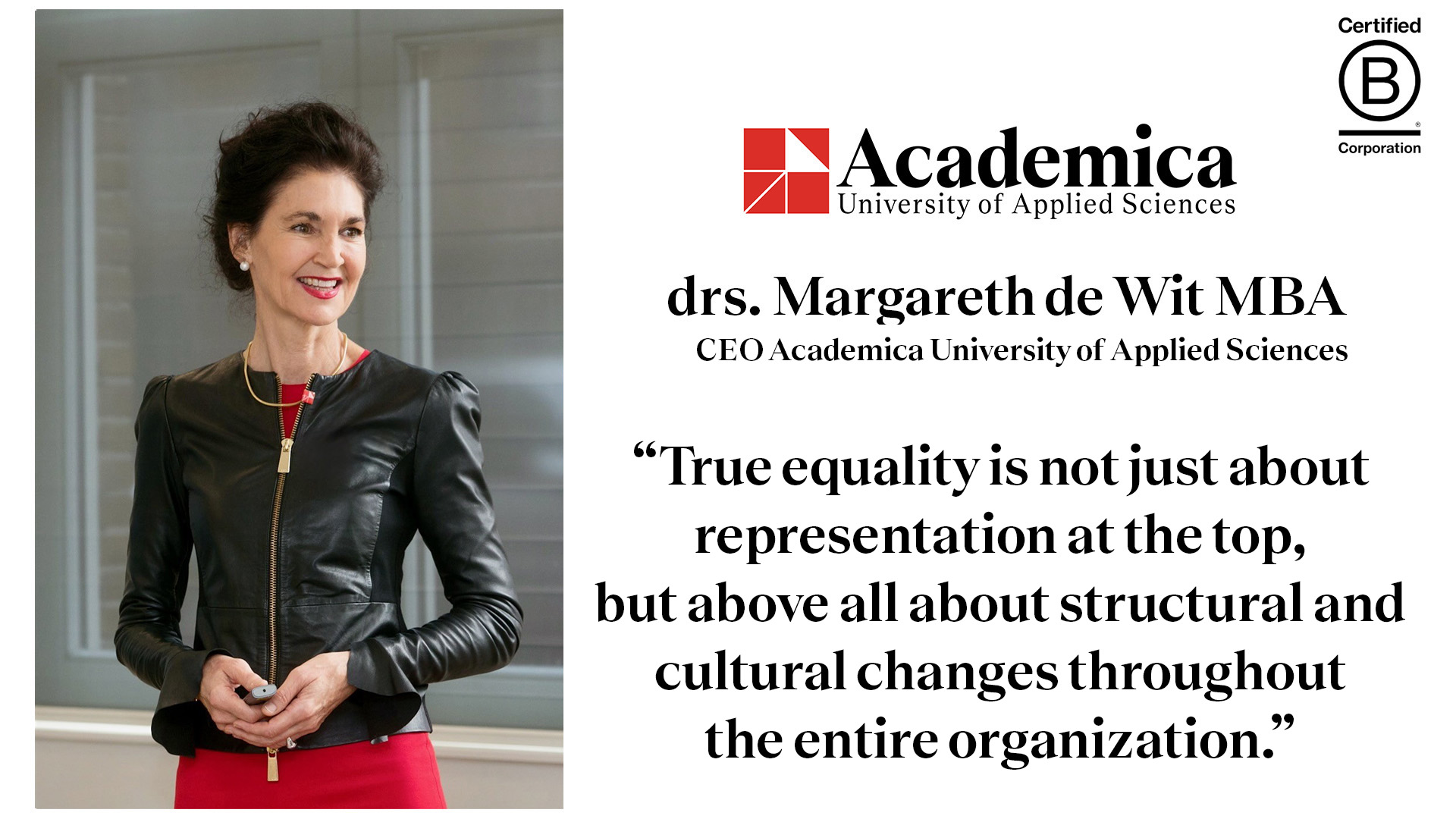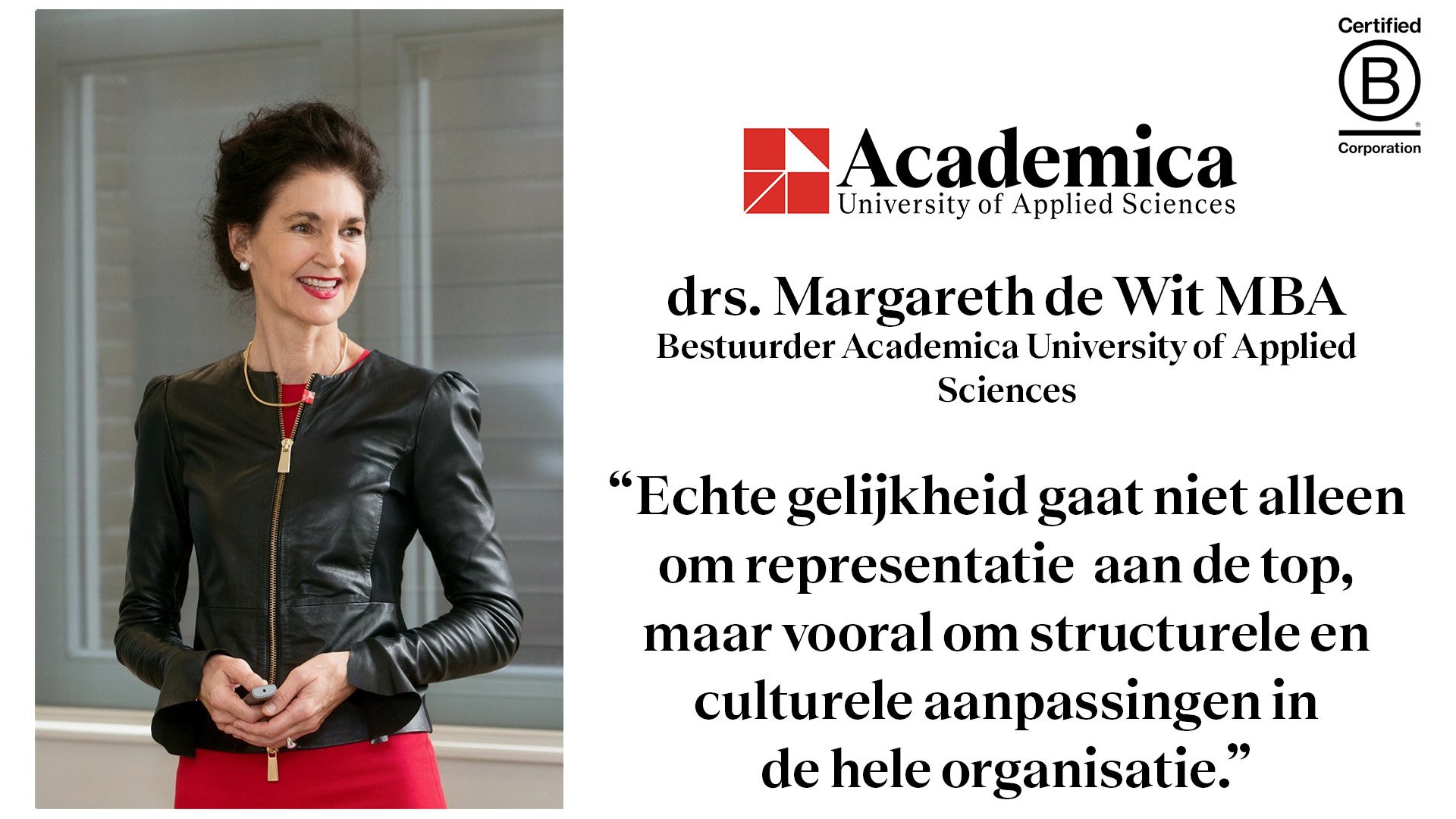Margareth de Wit, CEO and founder of Academica, is a leading figure in the field of leadership development and organizational change. With her years of experience, sharp analyses, and commitment to social impact initiatives, she actively contributes to the realization of the Sustainable Development Goals (SDGs), particularly SDG 5: Gender Equality. In this interview, Margareth reflects on the global barriers that continue to hinder women’s professional growth, as well as on the proven strength of female leadership. Her insights are grounded in extensive research and years of hands-on experience within organizations, both nationally and internationally.

B Corp Month, Generatie B en SDG5
What do you believe is the main reason why SDG 5, Gender Equality, remains one of the biggest global challenges?
Gender equality remains a global challenge due to deeply rooted social norms, institutional barriers, and structural inequalities. Cultural beliefs and traditional gender roles still limit the economic, social, and political participation of women. In addition, implicit biases and a lack of inclusive policies result in fewer opportunities for women to advance into leadership roles.
As I describe in my book Making Shift Happen, real change requires systemic adjustments and a shift in how organizations and political leaders recognize and support the contributions of women. Research from Women in Times of Crisis shows that female leaders tend to be more effective in times of crisis due to their combination of empathy and strategic insight. Unfortunately, the facts about the power of inclusive leadership and the daily reality of utilizing this potential are still far apart.
How do you see the broader benefits of achieving SDG 5—not just for women, but for society as a whole?
Promoting gender equality leads to stronger economic growth, greater innovation, and more social cohesion. This has been consistently demonstrated in numerous studies. Companies and organizations with diverse leadership teams perform better, and societies where women have equal opportunities experience less poverty and enjoy a higher quality of life.
Gender equality contributes to more stable economies, better healthcare, and more balanced decision-making processes at all levels. As discussed in Is Female Leadership Stronger?, an inclusive culture leads to greater employee engagement and more effective collaboration within teams.
You’ve conducted research on the effectiveness of women in leadership roles and the impact of having more women at the top.
What were the key findings of this research, and how can companies use these insights to improve leadership effectiveness and advance gender equality?
My research, along with data from Zenger Folkman, shows that women outperform men on 16 of the 19 core leadership competencies, including collaborates and promotes, communication, integrity, and problem-solving. Despite these results, women remain underrepresented at the top—partly due to a lack of self-confidence, particularly among younger women.
What do female leaders do differently?
Female leaders place greater emphasis on collaboration and participative decision-making. They create open work environments where employees feel heard and motivated to contribute. Their ability to lead adaptively and remain resilient in times of crisis is increasingly recognized, as also highlighted in Women in Times of Crisis.
How can women overcome the “confidence gap”?
Research by Zenger Folkman, which I discuss extensively in Webinar 8: Women as Leaders, shows that women tend to develop greater self-confidence later in their careers. This means organizations must actively invest in mentoring and leadership development for young women. It’s also vital to encourage women to build networks of supportive colleagues and role models around them.
Women often face obstacles in advancing to top positions. In your view, what are the most significant barriers, and how can we break through them?
Key barriers include unconscious biases, a lack of visible role models, unequal distribution of caregiving responsibilities, and limited access to professional networks. Additionally, women often prefer to execute tasks themselves rather than delegate—this can hinder their leadership growth.
Women must learn to share responsibility and distribute leadership tasks within their teams. Sometimes, we also see that women lack the ambition to grow into leadership roles—this often stems from internalized ideas about their contribution and place in the world.
What organizational changes are needed to provide women with equal opportunities in leadership and beyond?
Organizations must revise both policy and culture—implementing gender-neutral recruitment processes, fair promotion criteria, and an inclusive work environment. It’s unacceptable that, in the Netherlands, a significant pay gap between men and women still exists.
Men must also be engaged as allies in the journey toward gender equality. As Is Female Leadership Stronger? points out, companies that embrace gender diversity benefit from broader perspectives and greater innovation.
Companies with more gender diversity in leadership tend to perform better. In your view, what are the specific benefits for organizations, and how can they realize and retain such diversity?
Gender-diverse teams make better decisions, drive innovation, and boost employee engagement. In my book Making Shift Happen, I explore these benefits in depth. Annual performance reviews consistently show that organizations with robust diversity and inclusion policies are more successful.
Unfortunately, we’re now seeing a concerning trend, especially in the U.S., where some companies are reversing these policies. This rollback is troubling and counterproductive.
How does Academica actively contribute to gender equality?
Academica invests in research and programs that highlight and enhance the effectiveness of female leadership. Through our educational offerings, we invite everyone—but especially women—to strengthen their leadership potential. We emphasize that personal leadership is possible for everyone and that effectiveness increases when leadership is applied consciously.
We support women in embracing leadership, building strong networks, and amplifying their impact—not just through formal programs, but also via community initiatives. In Amsterdam, we work with a group of Moroccan mothers who are developing leadership by taking an active role in their children’s academic support. These efforts foster personal growth and community impact, serving as a catalyst for a more inclusive society.
How can companies create a culture that fosters equality—not only by appointing women to top roles, but by embedding equality into everyday structures and relationships?
True equality goes beyond representation at the top. It requires structural and cultural transformation across the entire organization. Equality emerges when leadership at every level is consciously applied to foster inclusion.
This means investing in the development of personal leadership for all employees. It starts with recognizing implicit biases, intentionally creating psychological safety, and rewarding behaviors that promote collaboration, empathy, and shared ownership—qualities in which female leaders tend to excel.
Daily work structures—such as meeting formats, decision-making processes, and career development conversations—must be reviewed for their inclusivity and openness to diverse voices.
Which specific policies can companies implement to actively promote gender equality, and how can they ensure these policies truly lead to equal opportunities for all?
In Making Shift Happen, I emphasize the importance of structural interventions. Effective measures include transparent promotion criteria, equal pay, inclusive hiring practices, and training programs that build women’s self-confidence and leadership skills.
Zenger Folkman’s data shows that women already excel in leadership competencies, yet their potential is often recognized too late. Companies can accelerate this by mentoring and sponsoring women early in their careers.
It’s also essential to continuously monitor the impact of these policies, using gender-neutral data analysis to track progress.
How do you see the role of B Corps in advancing gender equality (SDG 5), and how can the B Corp community help create equal opportunities for women globally?
B Corps are uniquely positioned to embed gender equality into their core impact goals. Certification standards encourage organizations to measure social and environmental impact—including contributions to SDG 5.
By sharing best practices, using gender equality as a benchmark, and setting clear targets for representation and inclusion, B Corps can play a standard-setting role. They can also influence supply chains and customers, demonstrating that equality and profitability can go hand in hand.
As a female leader, founder, and CEO of Academica, what have been the biggest challenges in your career, and how did you overcome them? What do you wish you had known earlier?
One of my biggest challenges was trying to do everything myself, instead of building a supportive network of women around me. I realized later in my career that powerful leadership isn’t about going it alone—it’s about asking for help, building coalitions, and leveraging strategic collaboration.
What I wish I had known earlier is that building confidence is a journey. As a woman, strengthening your voice in a predominantly male environment is something you have to actively cultivate. My experience mirrors Zenger Folkman’s findings: women often develop self-confidence later, despite their clear leadership potential.
Margareth de Wit makes it clear that gender equality is not a side issue—it’s essential for strong, future-proof organizations. Her call to action: invest in inclusive leadership, support women early in their careers, and transform the structures that perpetuate inequality. Gender equality is not only a matter of justice—it enhances performance, drives innovation, and strengthens social cohesion. Through Academica, Margareth shows how education and leadership can come together to advance SDG 5—every day, in both policy and practice.




